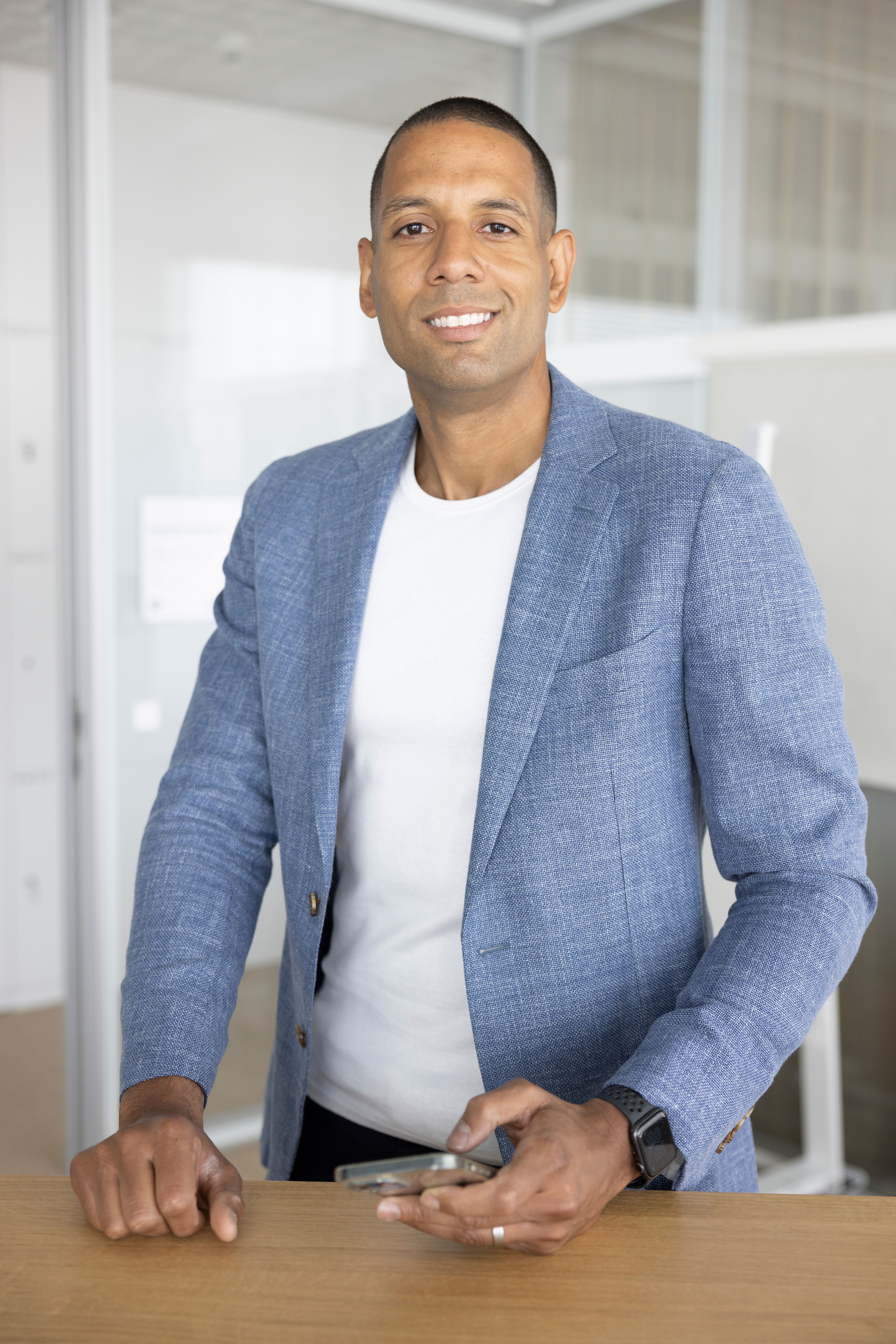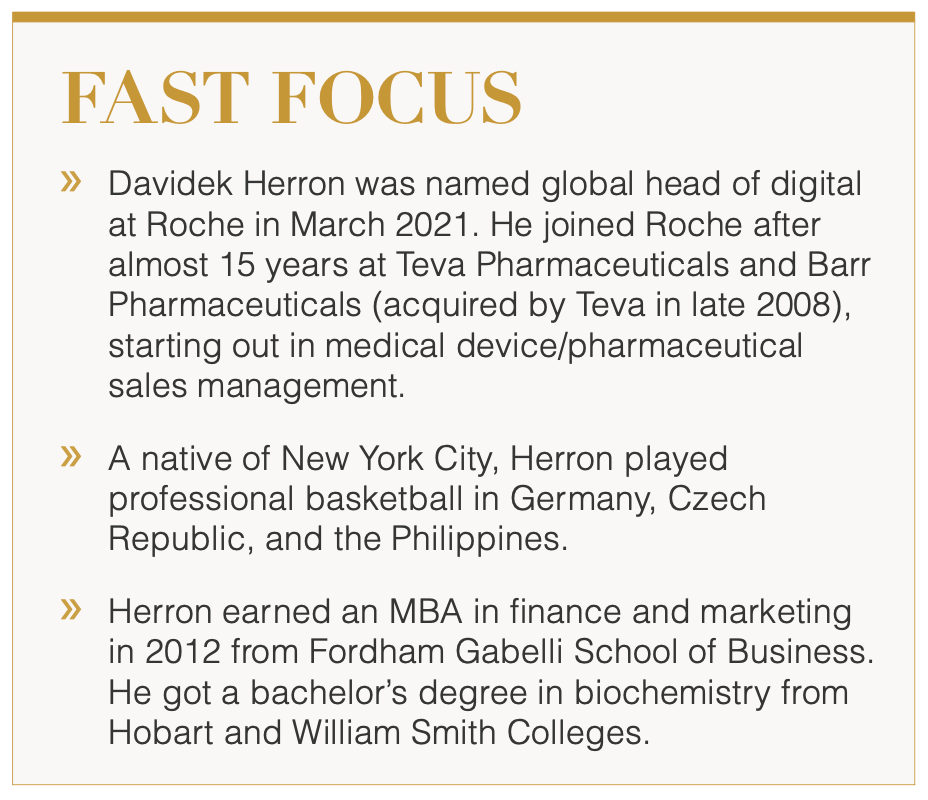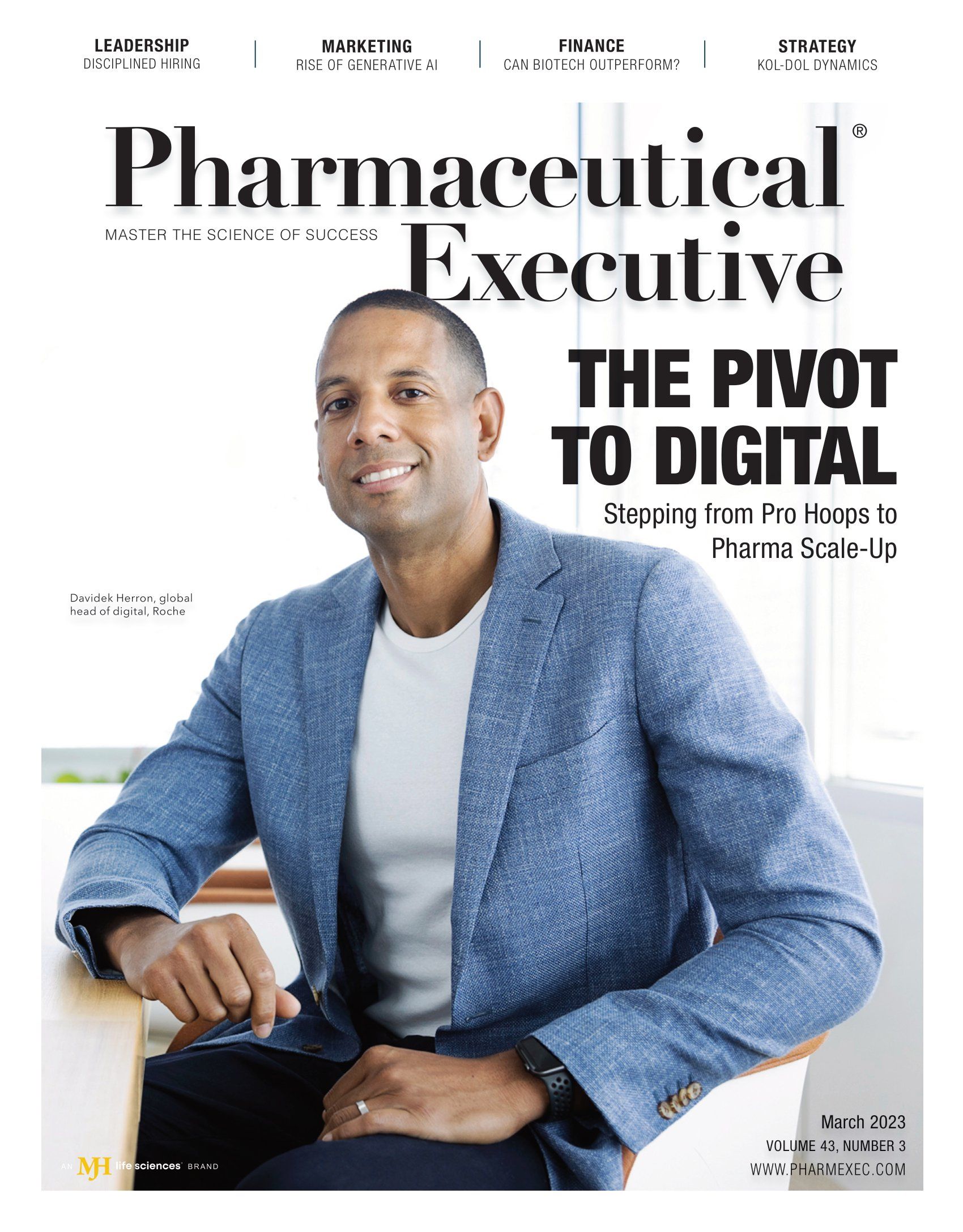The Pivot to Digital
Chronicling Davidek Herron’s career crossover from playing professional basketball to leading Roche’s digital transformation and scale-up efforts—and the team lessons learned along the way.

The typical path to a successful career in the pharmaceutical industry usually doesn’t include a stint as a professional basketball player and coach, but Davidek Herron hasn’t had the typical career. As the global head of digital at Roche, Herron’s responsibilities include the adoption of digital technologies across the company’s global operations and enabling the commercial models of the future for pharma. The goal is ensuring that these new operations are consistent and drive advancements in how Roche shows up in front of customers.
In a conversation with Pharmaceutical Executive, Herron explains that his unique work history is what provides him with the insight to understand global perspectives and processes. After attending college at Hobart and William Smith Colleges, Herron moved to Germany to play basketball. Since then, he’s lived and worked in the Czech Republic, Denmark, the Philippines, and the Netherlands. He currently resides in Switzerland with his family.
Originating from New York, Herron initially lived near the state’s capital before moving to New York City, where he spent much of his formative years. He describes himself as an inner-city kid who always dreamed of being a doctor. He attended college through an athletic scholarship and studied biochemistry while playing collegiate basketball and football. When graduation came, however, Herron found himself facing a unique and difficult decision. He had to decide whether to continue his education and go to medical school or pursue basketball as a professional career.
“I ultimately decided to play basketball. I had tryouts with some NBA Summer League teams, but I decided to play professional basketball in Europe. Being an inner-city kid, I never had a chance to explore the rest of the world,” says Herron. “What I knew about the world was what you saw in magazines and movies. My advisors at the time said it was a good opportunity to shape myself; so, I moved to Germany my first year after college, where I played professional basketball and coached as well.”
Herron’s basketball career eventually took him to the Czech Republic and then the Philippines. He credits these experiences for providing him with a viewpoint outside of the bubble he experienced while living in New York. With this new outlook on the world, Herron decided to move back to New York and pursue his dream of working in the medical industry.
He explains that since often the best way to be something is to work with the people doing it, he focused on getting a job in the medical industry, even if it wasn’t exactly what he was looking for or fully qualified for yet at the time.
Taking his shot
Despite not having the experience the company was initially looking for, Herron got a job with Barr Pharmaceuticals (later acquired by Teva Pharmaceuticals) as a salesperson focused on women’s specialty care in NYC. During this time, Herron worked with several world-renowned physicians. When he discussed his career goals with them, he learned that if he wanted to change the healthcare system, he should move up in the industry and break the old model.
“During my tenure at Teva Pharmaceuticals in the US, I had a great opportunity to be part of some amazing sales and medical teams,” Herron tells Pharm Exec. “Later, I moved into more transformational roles and had an opportunity to help create the first digital marketing organization for Teva at the time in the US. We scaled it up, and it was successful. I really wanted to understand the rest of the world, and I had some opportunities to move into a global role.”
This experience with creating a new model and scaling it up clearly had a profound impact on Herron. The concept of scaling projects and innovations from a small, localized scale to a much larger, company-wide one is important to him. Herron went back to college and earned an MBA in finance and marketing from Fordham University. While that was the last major degree that he earned, Herron says that he continues to focus on learning to this day.
“No matter how intelligent or smart you think you are, the digital and transformation space is moving so quickly,” he says. “Look at our ecosystem, it’s moving so fast; and in order to stay up to speed, you need to continue to learn. I had a lot of mentors and a good support system to help me on my journey. It’s key. And I always continue to refine that because you need to continue to create that circle around you and learn.”
One of the key lessons that Herron learned from his mentors was the concept of breaking bread with customers. According to Herron, this is the only way to truly understand the various regions and therapeutic markets of the world. Meeting directly with customers can provide data and information that helps provide a complete vision of what their unmet needs and issues are.
“Breaking bread with customers is critical. That helps you define the strategy and takes you to something that’s tangible and measurable,” he explains. “One thing I’ve been a victim of is when I get into these global roles, I can sometimes lose touch with reality. To combat that, my team and I have mandates to go out and meet with customers directly and understand what’s going on.”
Using this concept as inspiration, Herron created a new position for himself at Teva—head of human channels. He describes his team’s goal at the time as supporting Teva’s business goals by pulling off a financial magic trick: enabling countries to maintain top line while decreasing the bottom line. Herron and his team worked with the company’s general managers across Europe and the rest of world to find out what issues were preventing them from fulfilling their goals and finding or creating solutions for them.
Skilled at scaling
Around this time, Herron started to notice the importance of digital transformation at scale. He explains that by implementing new digital technologies and updating older processes, it became much easier for his teams to interact with vendors and other clients. After that, his team was charged with scaling up these new processes and finding ways to implement them across the entire company, where possible.
In 2021, Roche approached Herron, prompted, he recalls, by its interest in using digital transformation to find new models of doing business and then scaling these models up across the company to ensure that healthcare is affordable at scale.

Herron was offered a position at Roche that would allow him to focus his work on innovation and science. Remembering his goal of moving up in the industry to help change the model, he became the global head of digital at Roche.
“Digital updates can be looked at and implemented across multiple different facets of the pharmaceutical value chain,” says Herron. “Starting from early-stage drug development, clinical trials, manufacturing, to personalized healthcare or even commercialization efforts. Roche has a goal to double our medical innovations in lower- and middle-income countries. How you do that is [by] enhancing your experience and digital customer engagement. We work with various teams to figure [out] how to enable our global and local teams to meet that goal.”
By this point in his career, Herron had fully transitioned from sales leadership to digital transformations at scale. He says that this was due to his penchant for solving problems. For him, it wasn’t just about finding solutions but also figuring out ways to scale those solutions up so that the entire business can benefit from them on a global scale.
As an example of how he started to move away from sales leadership, Herron recounted a story from his days at Teva when he was still working in sales.
“There was a specific problem we had during that period of time,” he says. “In the US, we discovered that we had large spaces of territories that were either vacant or we couldn’t get salespeople there. This meant that we had areas that had large customer bases that we couldn’t get in front of. This was back in 2011, and we were experimenting and knew that the traditional model wouldn’t help.”
Herron started experimenting with different ways of approaching customers even if this meant simply locking himself in a room with a phone and computer. Through this experimentation, Herron and his team discovered previously unrealized paths to communicate with customers. Many of these new paths, he says, had to be built from the ground up because there wasn’t a multi-channel way of doing things like this back then.
“We started with a digital marketing team, then operations, and then everything else around that,” Herron tells Pharm Exec. “We learned early on that you can have the best technology in place, but if you don’t have the right business strategy and people to deliver it, it falls flat on its face. The vice versa of that is true as well. I found that it was a great business problem to solve, which led to making the switch from sales to digital transformation.”
Opening doors
Herron’s career has taken him across the world, but he hasn’t forgotten his beginnings. He’s called many countries home, but he still considers himself a New Yorker. Now that he’s found a path to success, which he’s defined as breaking things in order to improve the healthcare ecosystem for patients, he’s trying to make it easier for others with similar backgrounds to also find their way to the healthcare industry.
“I’m big into diversity and inclusion,” says Herron. “Being an African-American male in this industry, there’s not many of us, especially when you get into the more senior positions. I am doing a lot of mentoring in my community back in New York but also in communities here in Switzerland. You’d be surprised how people just want to see someone they can relate to in high-up positions. When I grew up, I didn’t know these opportunities even existed.”
Herron says that when it comes to improving diversity, equity, and inclusion (DE&I), a lot of industry efforts have delivered solid progress, but there are still some underrepresented groups that are falling behind. He considers the issue of diversity in the life sciences a work in progress, but it’s something that companies should start taking steps toward improving immediately. He sees it as an issue that won’t be resolved overnight, which is why it’s important to get working on it sooner rather than later.
It’s clear that Herron’s main driving goal is finding ways to scale solutions up to company-wide or even global scales. He sees a lot of individual silos or pockets of the industry that are making significant improvements, whether it’s with reaching out to customers in new or more efficient ways or achieving gains in DE&I. The problem, as he sees it, is that many organizations don’t have the ability to perform these things at scale. Technology is making communicating and data processing much more efficient, but the industry isn’t benefiting from these advancements as much as it can, Herron believes.
“Where I’m seeing the industry still struggle is doing these things at scale and being able to measure these innovations to see if it’s hitting the goals the companies need it to,” he says. “It comes back to some companies being very clear about their goals. At conferences, people are still talking about multichannel or omnichannel marketing. It’s the same stuff we were talking [about] 10 years ago. We were running into the same problems with data visibility, access, integrations, and things like that. If we can truly align, we’ll see the most movement and traction as an industry.”
Full-court vision
Herron has made a career out of finding solutions and creating new paths. Most people trying to break into the life sciences industry probably wouldn’t first find themselves playing basketball professionally. For Herron, however, the sport not only helped get him into college, but it also allowed him to leave the US and learn to start looking at issues from a global perspective. While he was always good at solving problems, the ability to think about these solutions on a larger scale is what made Herron capable of taking on a leadership position in pharma, with no looking back.
Mike Hollan is Pharm Exec’s editor and can be reached at
mhollan@mjhlifesciences.com.
